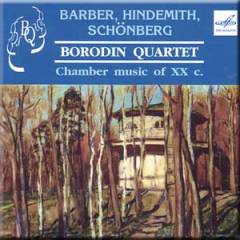Borodin Quartet - Barber, Hindemith, Schonberg (2005)
Borodin Quartet - Barber, Hindemith, Schonberg (2005)

Samuel Barber (1900-1981) String Quartet in B minor, Op. 11 1. Molto allegro appassionato 2. Molto adagio 3. Molto allegro Paul Hindemith (1895-1963) String Quartet №3, Op. 22 4. Fugato 5. Schnelle Achtel 6. Ruige Viertel 7. Massing schnelle Halbe 8. Rondo Arnold Schonberg (1874-1951) String Quatet №2 in F sharp minor Op. 10 9. Massig (Modersto) 10. Sehr rash 11. Litany. Langsam 12. Entrueckung. Sehr langsam Rostislav Dubinsky – violin (1-8) Yaroslav Alexandrov – violin (1-8) Dmitry Shebalin – viola (1-8) Valentin Berlinsky – cello (1-8) M. Kopelman – violin (9-12) A. Abramenkov – violin (9-12) Dmitry Shebalin – viola (9-12) Valentin Berlinsky – cello (9-12) Lyudmila Belograbina (11,12)
Samuel Barber's first and only string quartet didn't end up the way he intended it to, for the second movement eventually overshadowed the entire opus when he transcribed it for string orchestra as the Adagio for Strings. In addition, a projected last movement never really came together, and the piece as a whole became marked as a vehicle for bringing the Adagio to life. The first movement has merit, however, in that it shows Barber experimenting with a style somewhat removed from his usual hyper-melodic idiom. Barber composed the piece in the summer of 1936 at St. Wolfgang, Austria, a small mountain town near Salzburg, where he and Gian Carlo Menotti had rented a cottage. It was premiered at the American Academy in Rome by the Pro Arte Quartet in December of the same year. The finished work has two movements. The first, Molto allegro e appassionato, is structured in a loose sonata form. Reminiscent of Beethoven and unlike, in terms of rhetoric, most of Barber's works, it is structured around rhythmic motifs rather than on the basis of a central, emotionally charged melody. The second movement, Molto adagio; molto allegro, begins with one of the most famous melodies in history, the slow, sensitive cantilena which became the Adagio for Strings. The second half of the movement, Molto allegro (originally intended to be the last movement) is a rather unexciting and perfunctory recapitulation of first-movement material. ---Graham Olson, Rovi
Paul Hindemith wrote seven String Quartets, all of which reflect the experience and practical assurance of a distinguished violinist and, later, violist. No 3 followed early in 1920 and was an instant success, a thrilling example of Hindemith’s concise imagination at work. This passionate quartet, with its richly varied material, is one of his supreme chamber masterpieces. --- naxos.com
The String Quartet No. 2, Op. 10, of Arnold Schoenberg is one of the key works of musical modernism. Composed between March 1907 and August 1908, its last movement marks the decisive point at which Western art music moved from a tonally based harmonic structure to what has been called an atonal harmonic structure. Prior to the Quartet No. 2, Schoenberg wrote in the highly chromatic post-Wagnerian harmonic language of the fin de siècle, a language that took tonal music to the limits of its coherence by delaying the resolution of dissonances for longer and longer periods. After the Quartet No. 2, Schoenberg, then his pupils and then much of Western art music abandoned tonality for harmonic structures that not only allowed an extremely high level of chromatic dissonance, but which no longer required the resolution of those dissonances.
The Quartet No. 2 itself begins tonally, and its first two movements are, in fact, in F sharp minor. The opening movement is in sonata form with the usual harmonic relation between keys. The second movement is a scherzo with trios, the second of which ends with a quotation from the plague song, Ach, Du Liebe Augustine. The third movement is in E flat minor, one of the most difficult keys for a string player to perform in, and sets Stefan George's poem "Litanei" (Litany) for soprano, the first time a vocalist had been used in a piece of chamber music. The final movement sets another poem by George, entitled "Entruckung" (Transport), for soprano and, although the movement ends on an F sharp major triad, it is for almost all the rest of its length, completely unconcerned with tonal harmonic relationships and structures. Instead, it relies on George's text and motivic relationships to give coherence to the music.
Interestingly, while the opening movements of the Quartet No. 2 are anguished in tone and the third movement is one of the most harrowing pieces Schoenberg was ever to write, the closing movement is calm and even serene in tone, despite being harmonically atonal. In part, the emotional sequence of the quartet is autobiographical: while he was composing the quartet, Schoenberg's wife, Mathilda, left him and their children for the painter Richard Gerstle. Although Mathilda was later persuaded by Schoenberg's pupil Anton Webern to return to her family, her return caused the unstable Gerstle to hang himself, and this in turn caused her to lose her own sanity. Shortly after the completion of the Quartet No. 2, Mathilda was placed in an institution, where she remained for the rest of her of her life. --- James Leonard, Rovi
download (mp3 @320 kbs):
yandex 4shared mega mediafire cloudmailru uplea ge.tt








